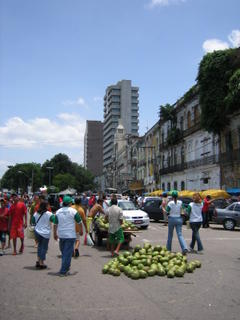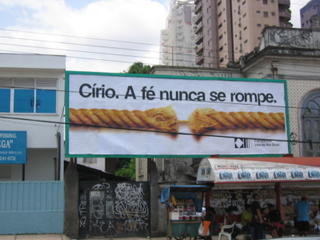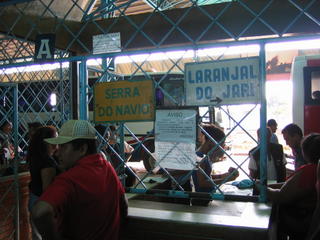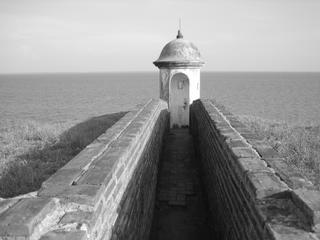 Mangeirão stadium, Marambaia neighborhood, and Baía do Guajará
Mangeirão stadium, Marambaia neighborhood, and Baía do Guajará
 Rio Guamá entering the Baía do Guajará and view of downtown Belém
Rio Guamá entering the Baía do Guajará and view of downtown Belém
Reflections on my experiences in Brazil and beyond



Piles of pineapples - R$1.50 each.

Iara
The curupira is a little more imaginative. This forest creature can become invisible and has feet that point backwards. I’m not sure how much of this is re-envisioned environmental mumbo jumbo, but the plaque said the curupira protects regular forest dwellers so long as they only hunt for food and use forest resources for what they need. If the Indian uses the forest in an unsustainable manner, the curupira becomes his enemy and can make him get lost in the forest, always coming back to the starting point.

Curupira
I wonder what the curupiras are doing about the topic raised in this article in today’s “New York Times.” The article is about illegal logging in the Amazon, and all of the places mentioned are in the state of Pará. One thing I’m working on at my internship is alternative sanctions to environmental crimes since the penalties established in the laws don’t work. With the drought in the Amazon and the dry season just beginning, this is certain to be a very bad year for logging and forest fires.
Get busy, little curupiras.
*This isn’t as far-fetched as it sounds. For most of the 1800’s, Brazil had a monopoly on the production of rubber, which was in great demand during the Industrial Revolution. Because of the rubber trade, Belém and Manaus became fabulously wealthy.

Annoying lady with microphone next to the fruit canoe
I pigged out on bananas, watermelon, cashew fruit, star fruit, acerola (red, tiny, and tart), papaya, and cacao (from which chocolate is made).
I also helped myself to some tacacá. Tacacá is an indian dish found all over Belém and is quite tasty. It is made from tucupi (lemony-tart juice of cassava) and is served with jambu (alkaloid spinach), and salty dried shrimp. It also has goma, which is made from finely ground cassava and has the consistency of snot. My first experience with tacacá was not very good as there was WAY too much goma in my serving, so I felt like I was drinking a bowl full of warm loogies. But this serving was more balanced and very enjoyable.

 Our Lady of Nazaré
Our Lady of Nazaré
The procession was similar to the one on Saturday night except there were a lot more people. I heard estimates of two million floated but that seems too high and might have been a count for the entire weekend. Anyway, it doesn’t matter as Círio claims the title of Brazil’s largest religious procession without an apparent rival.
The other difference was that today some of the participants carried the wooden house, boats, and wax body parts mentioned in an earlier post. I didn’t see as many as I expected and there were more boats than anything else. Also, some of the houses were made out of Styrofoam, which I guess is a modern adaptation.

This guy was limping.

Posters calling for justice for Dorothy Stang, the murdered American nun
Another difference was that the corda was cut, which is sometimes done to protect both the people pulling it from being stampeded and the relic from toppling out of the carriage. When it is cut, people want a souvenir for what ever reason. There was a mini-mob trying to get a piece of the rope right where I was standing. I did my good deed for the day by picking up an about-to-be-smashed little girl and setting her on top of a drink cart.



street vendor selling wax effigies
The images have expanded into a cottage industry that makes brinquedos de miriti, brightly colored toys made out of balsa wood. I bought a little fish.


NS de Nazaré arriving on the big white ship. The relic is on a pedestal with yellow flowers.
After the Romaria Rluvial, the Romaria dos Motociclistas began. Along with hundred of people on motorcycles, the relic went up Avenida Nazaré, a major street of Belém, to Colégio Gentil, which is next to the basilica. Later this afternoon there will be yet another procession transferring the relic to Catedral da Sé.


Doomed.
For Catholics in Belém, Círio is more important than Christmas. There are similarities between the two events. Lots of shops are decorated with images of the virgin of Nazaré, the guards at my apartment complex put out a little contribution box (I contributed), and people are running around in a frenzy buying things. Perhaps because of the frantic shopping or the sky-high price of duck, my laundry lady tried to charge me 50% more than usual for washing my clothes (I refused).
And, like Christmas, there is tacky commercialization, except here the religious imagery is more explicit. I took some photos of my favorite billboards around town:

Círio. Faith never breaks.
(by Companhia do Vale do Rio Doce, a huge mining company)
Our Lady of Nazaré, light up (enlighten) our families.
(by Celpa, the state electric company)
 The entrance to the passenger area of the bus station in Macapá had sobering reminders of Brazil’s problem with human trafficking. The advisories posted beneath the city plaques state that “no child and/or adolescent can travel without necessary documentation” and that “the child who is not in the company of parents, siblings, aunts or uncles, or grandparents, must present judicial authorization.” With that happy send-off, I embarked on an uneventful trip through rainforest, former rainforest, and savannah.
The entrance to the passenger area of the bus station in Macapá had sobering reminders of Brazil’s problem with human trafficking. The advisories posted beneath the city plaques state that “no child and/or adolescent can travel without necessary documentation” and that “the child who is not in the company of parents, siblings, aunts or uncles, or grandparents, must present judicial authorization.” With that happy send-off, I embarked on an uneventful trip through rainforest, former rainforest, and savannah.
Laranjal do Jari as seen from across the Jari River
I spent almost all of Sunday at the waterfall. I first had to hire a boat and driver who would take me up the Rio Jari to Santo Antônio. This wasn’t difficult and only involved a little bargaining as the prices are pretty set. The trip up the river in the morning was good. It was too late to see much wildlife, but cruising up a branch of the Amazon River in the cool morning was very relaxing. Although it is the dry season and the flow of the river over the falls wasn’t as heavy as it could have been, the falls were still very impressive and the setting couldn’t be more exotic.
Cachoeira Santo Antônio
After a big group of Brazilians left, I was the only visitor at the falls for a few hours. The good thing about there being less water was that I could get very close to the falls. I spent the day swimming in the river, climbing along the rocks, and frolicking in the falls. I took care not to pee while swimming so as not to attract the candirú fish.*
I would have preferred to take a boat back to Macapá for variety, but none were leaving on Monday morning. The return bus ride was more eventful than Saturday’s trip. The woman in front of me puked up an orange out the window in the second hour of the trip. Fortunately I saw this coming and closed my window just in time. I did have to look at a barf splatter for the rest of the trip, but that is better than having it on your face. Upon arrival in Macapá, I noticed that something, beer I think, leaked all over the backpack I had to carry around with me until my flight left at 1 AM.
*While reports may be exaggerated, the fish is real. I saw a preserved specimen in Manaus in 2003. Few things sound more unpleasant than having a catfish shoved up my urethra and feeding off of me. Why take the chance?
 On Friday I explored the pleasant and sleepy capital city. After finding a hotel, I visited the big and impressive 18th century Fortaleza de São José which was built to solidify Portuguese control over the upper Amazon and fend off challenges from the French. While Amapá is Brazilian, the French still partly succeeding in taking over, as restaurant menus are bilingual in Portuguese and French and there is a large French cultural center. There were also quite a few French tourists in the capital, and I sat in front of a family speaking French on the 6 hour bus ride to Laranjal do Jari on Saturday.
On Friday I explored the pleasant and sleepy capital city. After finding a hotel, I visited the big and impressive 18th century Fortaleza de São José which was built to solidify Portuguese control over the upper Amazon and fend off challenges from the French. While Amapá is Brazilian, the French still partly succeeding in taking over, as restaurant menus are bilingual in Portuguese and French and there is a large French cultural center. There were also quite a few French tourists in the capital, and I sat in front of a family speaking French on the 6 hour bus ride to Laranjal do Jari on Saturday.

Curiaú river